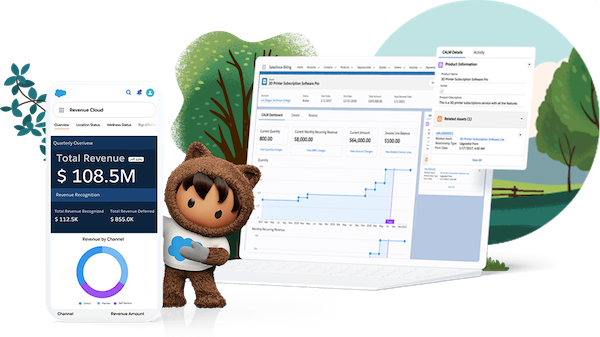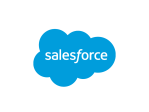Enterprise Resource Planning (ERP) is software used by organisations to integrate multiple business functions into one system. It includes various activities, such as accounting, human resources, project management, sales, inventory and order management, and compliance.
An ERP system uses a shared database that enables employees from across a business to see the same information — a ‘single source of truth’. With everyone’s data in the same place, companies can use an ERP to streamline processes and information across the entire business.
An ERP is different from a customer relationship management (CRM) system, like Salesforce’s Customer 360. But you can integrate them to work together.
This guide outlines the benefits of using an ERP system, the difference between an ERP and CRM, and why you should consider integration.

What are the benefits of using an ERP system?
There are many benefits of using an ERP system for businesses. Having one unified place for all data can reduce silos and improve efficiency across an enterprise.
Some of the main advantages of using an ERP include:
Enhanced collaboration
Collaboration is simplified when all data is shared, and employees can easily see and share information on contracts, requisitions, and purchase orders. When everyone in the business is connected to the same information, collaboration comes far more easily.
Improved business insight
Real-time information allows everyone in an organisation to have an up to date view of data, which can improve decision making across all areas of a business. With an ERP, everyone is looking at the same information simultaneously, and there is no risk of specific departments looking at outdated documents.
Better financial compliance
The financial controls with an ERP reduce any margin for error. Increased data integrity means users will always be working with up to date information, which also reduces the chances that something will be missed, and can improve financial compliance.
Is Salesforce ERP?
Salesforce is not an ERP. Salesforce offers various business solutions, which can be integrated to enhance and support your ERP but it does not provide an ERP product.
At the heart of Salesforce is its CRM — Customer 360, which is the world’s #1 CRM system.
ERPs and CRMs are both used by businesses to improve efficiency and streamline operations, but they serve distinct purposes.
An ERP helps businesses connect their financial and operational systems to a central database, while a CRM helps manage customer interactions specifically.
Although CRMs are not ERPs, you can integrate them to enhance all aspects of business operations and processes.
Salesforce also offers other solutions, such as Revenue Cloud, designed to complement ERPs. Part of the Salesforce Customer 360 Platform, Revenue Cloud brings together Configure, Price, Quote (CPQ) and Billing, Partner Relationship Management and B2B Commerce capabilities. This helps businesses take control of their revenue growth across every channel and make billing more strategic. Revenue Cloud is not an ERP and works best when integrated with an ERP.
One thing that differentiates Revenue Cloud and an ERP is that Revenue Cloud helps users transition to recurring revenue, consumption, and usage-based models. Revenue Cloud is designed to handle these models, whereas ERPs are suited to one time transactions.
Why integrate ERP and CRM?
A CRM provides businesses with consolidated views of various functions, such as sales and service, while an ERP includes functionality like inventory management, production, supply chain, and finance. Integrating them gives your business a complete view of its customers and its financial performance in one place.
There are many reasons why businesses should consider integrating their ERP with their CRM, including:
End-to-end visibility of your business processes
You can take complete customer views to the next level with the added understanding of how they impact your business financials.
Improved efficiency
Workflows can automate tasks between CRMs and ERPs and enhance your productivity. There is no need to manually enter CRM data into an ERP once integrated.
Better employee collaboration
Empower your employees with access to critical customer information, even if they do not work in your service or sales team. Giving everyone access to real-time data helps ensure the right decisions are made across the organisation.
Reduced data duplication
When you have an ERP and a CRM working separately, you may have customer data existing in both, leading to inaccuracies and out-of-date information. But even when it is accurate, it can cause unnecessary duplication, and it’s hard to determine which should be the master record. Integrating ensures there is only one record.
Speed up sales approvals
Sales and operations teams can move customers through an approvals process much quicker when they can be sure they have real-time customer data.
Lowered cost of IT support
When you have just one system to maintain, your IT support cost will reduce. With a fully integrated solution, you only need to train teams on one platform, reducing downtime.
More accurate reporting and forecasting
Because all of your data is accurate and in one place, an ERP improves reporting processes. Accurate forecasting is critical for a growing business, and integrating with an ERP automates some of the manual processes that can cause errors and delays in reporting.
How can you integrate Salesforce CRM with an ERP?
Nowadays, it is simple to integrate Salesforce with your ERP and reap the benefits.
You used to need to use complex systems to integrate legacy ERP systems with Salesforce CRM. However, modern cloud-based ERPs allow for easy integration. With some providers building ERP natively on the Salesforce platform, it is possible to run both CRM and ERP seamlessly on Salesforce.
One aspect of Salesforce that makes for straightforward integration is Salesforce Billing. Salesforce Billing converts Salesforce CPQ’s lead-to-order data into transactional data. The conversion allows ERP systems to inherit matching data, which they can use for accounting functions.
Salesforce’s MuleSoft also makes it easy to integrate CRM, ERP, and other applications. The MuleSoft Anypoint Platform helps businesses integrate data and connect experiences from any system. With MuleSoft, you can bring data from any third-party system such as SAP, Oracle, Workday into Salesforce. Visit our MuleSoft Anypoint Platform overview to learn more.




























